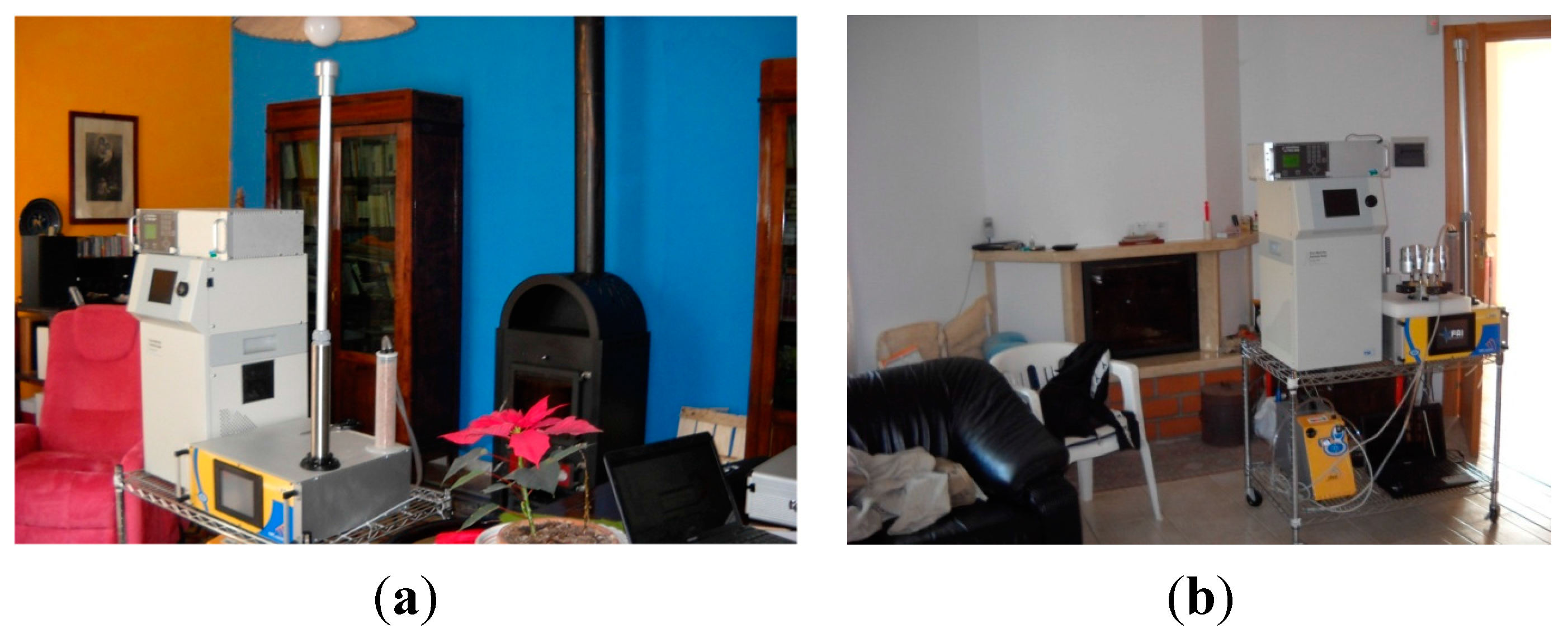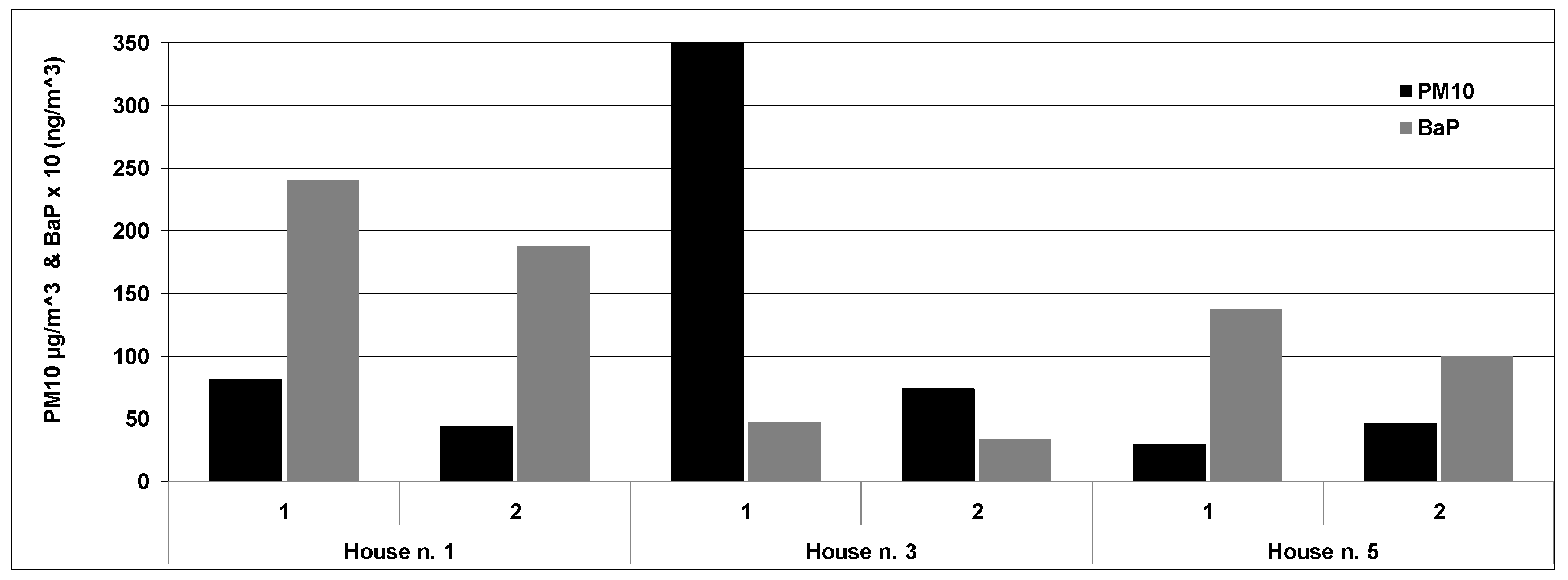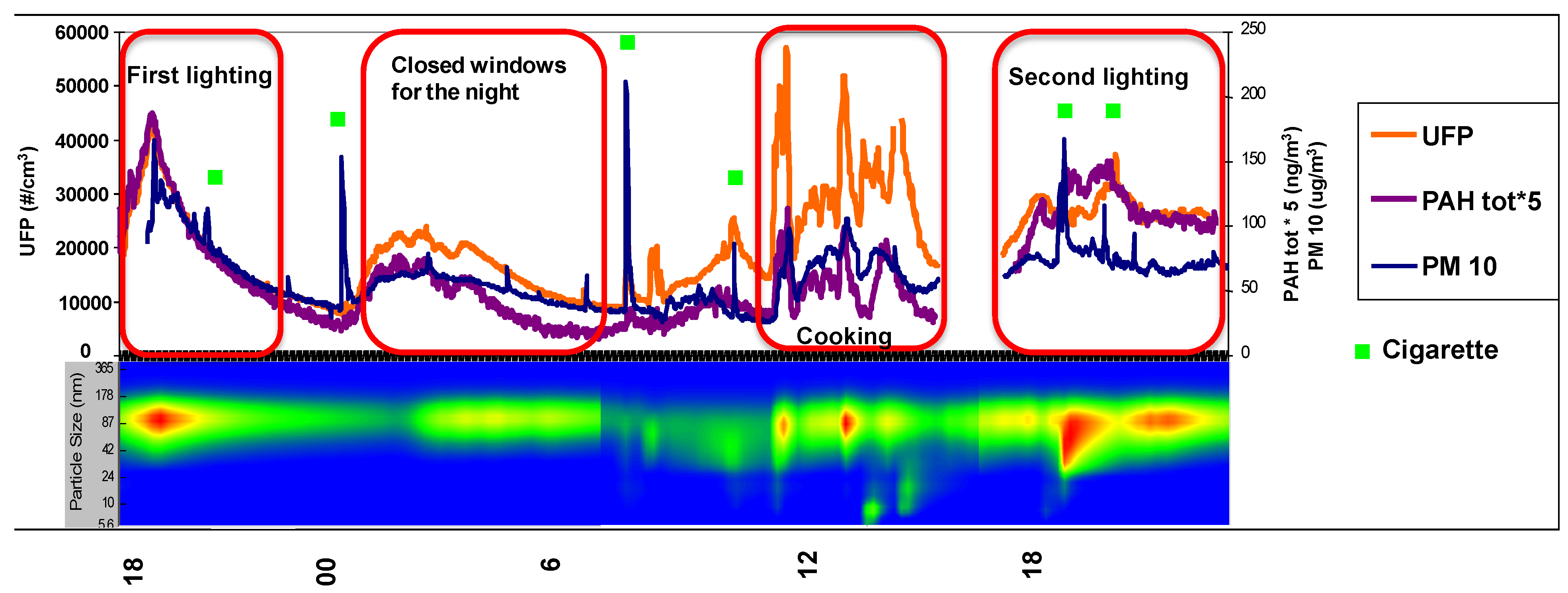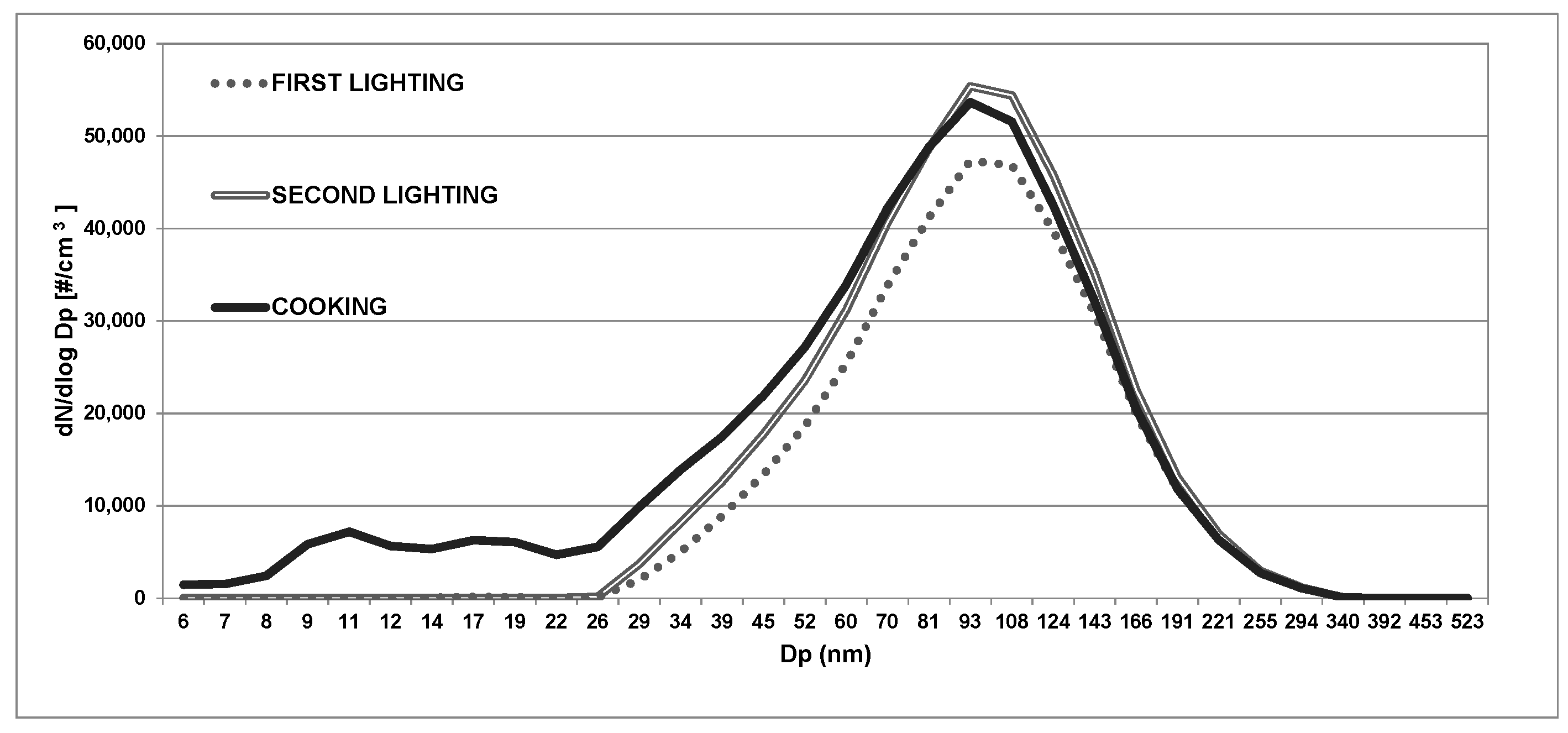Discontinuous and Continuous Indoor Air Quality Monitoring in Homes with Fireplaces or Wood Stoves as Heating System
Abstract
:1. Introduction
2. Experimental Section
| Monitored Houses | Heating System | Amount of Wood Burned (kg) | Type of Wood Burned | Room Volume (m3) |
|---|---|---|---|---|
| House 1 | Wood stove | 16 | Olive tree wood | 98.0 |
| House 2 | Fireplace | 15 | Olive and almond tree wood | 72.0 |
| House 3 | Wood stove | 20 | Olive and pine wood | 42.0 |
| House 4 | Fireplace | 18 | Olive and almond tree wood | 40.0 |
| House 5 | Fireplace | 12 | Olive tree wood | 103.0 |
| House 6 | Fireplace | 18 | Olive tree wood | 56.0 |

3. Results and Discussion
| Monitored Houses | Activities | B(a)A | B(b+j)F | B(k)F | B(a)P | DBA | IP | BgP | (ng/m3) | PM10 (ng/m3) |
|---|---|---|---|---|---|---|---|---|---|---|
| House 1 | Lighting | 73.8 | 31.1 | 9.7 | 19.7 | 20.9 | 19.5 | 38.0 | 212.7 | 66.3 |
| No lighting | 29.5 | 26.6 | 8.7 | 16.6 | 15.1 | 15.8 | 27.6 | 139.9 | 54.2 | |
| House 2 | Lighting | 97.0 | 22.5 | 9.1 | 12.9 | 11.0 | 10.6 | 22.8 | 185.9 | 74.8 |
| No lighting | 34.3 | 12.1 | 3.9 | 6.5 | 8.7 | 7.4 | 16.1 | 89.0 | 54.7 | |
| House 3 | Lighting | 46.6 | 12.0 | 4.0 | 4.1 | 7.3 | 5.9 | 13.0 | 92.9 | 212.3 |
| No lighting | 4.7 | 5.1 | 2.6 | 3.2 | 3.3 | 3.1 | 5.5 | 27.5 | 52.9 | |
| House 4 | Lighting | 99.5 | 17.7 | 5.4 | 16.6 | 12.8 | 9.3 | 21.5 | 182.8 | 80.7 |
| No lighting | 24.6 | 14.7 | 5.1 | 9.3 | 9.9 | 8.6 | 20.0 | 92.3 | 53.8 | |
| House 5 | Lighting | 52.1 | 19.7 | 14.1 | 11.9 | 14.2 | 9.4 | 24.3 | 145.7 | 38.2 |
| No lighting | 30.3 | 11.1 | 4.0 | 5.0 | 14.7 | 7.5 | 17.3 | 89.9 | 22.8 | |
| House 6 | Lighting | 45.5 | 11.6 | 3.2 | 5.6 | 8.6 | 6.1 | 12.5 | 93.0 | 67.1 |
| No lighting | 1.7 | 2.6 | 1.3 | 1.5 | 2.0 | 1.7 | 2.9 | 13.7 | 45.9 |

| Diagnostic Ratios | Biomass Burning in Olive Tree Fields [47] | This Study | |
|---|---|---|---|
| Lighting | No Lighting | ||
| IP/BgP | 1.12 | 0.5 | 0.5 |
| IP/(IP+BgP) | 0.53 | 0.3 | 0.3 |
| BgP/BgP | 1.55 | 0.5 | 0.5 |
| BgP/IP | 1.38 | 1.1 | 0.9 |


4. Conclusions
Author Contributions
Conflicts of Interest
References
- Zhang, J.J.; Smith, K.R. Indoor air pollution: A global health concern. Br. Med. Bull. 2003, 68, 209–225. [Google Scholar] [CrossRef] [PubMed]
- Ashmore, M.R.; Dimitroulopoulou, C. Personal exposure of children to air pollution. Atmos. Environ. 2009, 43, 128–141. [Google Scholar] [CrossRef]
- Weschler, C.J. Changes in indoor pollutants since the 1950s. Atmos. Environ. 2009, 43, 153–169. [Google Scholar] [CrossRef]
- Park, H.S.; Ji, C.; Hong, T. Methodology for assessing human health impacts due to pollutants emitted from building materials. Build. Environ. 2016, 95, 133–144. [Google Scholar] [CrossRef]
- Isaxon, C.; Gudmundsson, A.; Nordin, E.Z.; Lönnblad, L.; Dahl, A.; Wieslander, G.; Bohgard, M.; Wierzbicka, A. Contribution of indoor-generated particles to residential exposure. Atmos. Environ. 2015, 106, 458–466. [Google Scholar] [CrossRef]
- Bekö, G.; Weschler, C.J.; Wierzbicka, A.; Karottki, D.G.; Toftum, J.; Loft, S.; Clausen, G. Ultrafine particles: Exposure and source apportionment in 56 Danish homes. Environ. Sci. Technol. 2013, 47, 10240–10248. [Google Scholar] [CrossRef] [PubMed]
- Airborne Particles: Exposure in the Home and Health Effects. Available online: http://www.einsten.net/pdf/0100250502.pdf (accessed on 23 October 2015).
- He, C.; Morawska, L.; Hitchins, J.; Gilbert, D. Contribution from indoor sources to particle number and mass concentrations in residential houses. Atmos. Environ. 2004, 38, 3405–3415. [Google Scholar] [CrossRef] [Green Version]
- Arku, R.E.; Adamkiewicz, G.; Vallarino, J.; Spengler, J.D.; Levy, D.E. Seasonal variability in environmental tobacco smoke exposure in public housing developments. Indoor Air 2015, 25, 13–20. [Google Scholar] [CrossRef] [PubMed]
- Elliott, T.G.; Ellison, M.C.; Matt Earnest, C.; Brent, S. Indoor air pollution in developing countries: Research and implementation needs for improvements in global public health. Am. J. Public Health 2013, 103, e67–e72. [Google Scholar]
- De Gennaro, G.; Dambruoso, P.R.; Loiotile, A.D.; di Gilio, A.; Giungato, P.; Tutino, M.; Marzocca, A.; Mazzone, A.; Palmisani, J.; Porcelli, F. Indoor air quality in schools. Environ. Chem. Lett. 2014, 12, 467–482. [Google Scholar] [CrossRef]
- Monn, C.; Fuchs, A.; Kogelschatz, D.; Wanner, H. Comparison of indoor and outdoor concentrations of PM10 and PM2.5. J. Aerosol Sci. 1995, 26, S515–S516. [Google Scholar] [CrossRef]
- Tucker, W.G. An overview of PM2.5 sources and control strategies. Fuel Process. Technol. 2000, 65–66, 379–392. [Google Scholar] [CrossRef]
- Verriele, M.; Schoemaecker, C.; Hanoune, B.; Leclerc, N.; Germain, S.; Gaudion, V.; Locoge, N. The MERMAID study: Indoor and outdoor average pollutant concentrations in ten low energy school buildings in France. Indoor Air 2015, 11. [Google Scholar] [CrossRef] [PubMed]
- Carteret, M.; Pauwels, J.F.; Hanoune, B. Emission factors of gaseous pollutants from recent kerosene space heaters and fuels available in France in 2010. Indoor Air 2012, 22, 299–308. [Google Scholar] [CrossRef] [PubMed]
- Wallace, L.; Wang, F.; Howard-Reed, C.; Persily, A. Contribution of gas and electric stoves to residential ultrafine particle concentrations between 2 and 64 nm: Size distributions and emission and coagulation rates. Environ. Sci. Technol. 2008, 42, 8641–8647. [Google Scholar] [CrossRef] [PubMed]
- Wallace, L.; Ott, W. Personal exposure to ultrafine particles. J. Expo. Sci. Environ. Epidemiol. 2011, 21, 20–30. [Google Scholar] [CrossRef] [PubMed]
- Glytsos, T.; Ondracek, J.; Dzumbova, L.; Kopanakisa, I.; Lazaridis, M. Characterization of particulate matter concentrations during controlled indoor activities. Atmos. Environ. 2010, 44, 1539–1549. [Google Scholar] [CrossRef]
- Wang, B.; Lee, S.C.; Ho, K.F.; Kang, Y.M. Characteristics of emissions of air pollutants from burning of incense in Temples, Hong Kong. Sci. Total Environ. 2007, 377, 52–60. [Google Scholar] [CrossRef] [PubMed]
- Lahiri, T.; Ray, M.R. Effects of indoor air pollution from biomass fuel use on women’s health in India. In Air Pollution; Gujar, B.R., Molina, L.T., Ojha, C.S.P., Eds.; CRC Press: Boca Raton, FL, USA, 2010; pp. 135–163. [Google Scholar]
- Tuckett, C.J.; Holmes, P.; Harrison, P.T.C. Airborne particles in the home. J. Aerosol Sci. 1998, 29, S293–S294. [Google Scholar] [CrossRef]
- Long, C.M.; Suh, H.H.; Koutrakis, P. Characterization of indoor particle sources using continuous mass and size monitors. J. Air Waste Manag. Assoc. 2000, 50, 1236–1250. [Google Scholar] [CrossRef] [PubMed]
- Morawska, L.; Zhang, J. Combustion sources of particles: Health relevance and source signatures. Chemosphere 2002, 49, 1045–1058. [Google Scholar] [CrossRef]
- Abt, E.; Suh, H.H.; Catalano, P.; Koutrakis, P. Relative contribution of outdoor and indoor particle sources to indoor concentrations. Environ. Sci. Technol. 2000, 34, 3579–3587. [Google Scholar] [CrossRef]
- Afshari, A.; Matson, U.; Ekberg, L.E. Characterization of indoor sources of fine and ultrafine particles: A study conducted in a full-scale chamber. Indoor Air 2005, 15, 141–150. [Google Scholar] [CrossRef] [PubMed]
- Brauer, M.; Hirtle, R.; Lang, B.; Ott, W. Assessment of indoor fine aerosol contributions from environmental tobacco smoke and cooking with reportable nephelometer. J. Expo. Anal. Environ. Epidemiol. 2000, 10, 136–144. [Google Scholar] [CrossRef] [PubMed]
- Bruce, N.; Perez-Padilla, R.; Albalak, R. Indoor air pollution in developing countries: A major environmental and public health challenge. Bull. World Health Organ. 2000, 78. [Google Scholar] [CrossRef]
- Smith, K.R.; Samet, J.M.; Romieu, I.; Bruce, N. Indoor air pollution in developing countries and acute lower respiratory infections in children. Thorax 2000, 55, 518–532. [Google Scholar] [CrossRef] [PubMed]
- Siddiqui, A.R.; Lee, K.; Bennett, D.; Yang, X.; Brown, K.H.; Bhutta, Z.A.; Gold, E.B. Indoor carbon monoxide and PM2.5 concentrations by cooking fuels in Pakistan. Indoor Air 2009, 19, 75–82. [Google Scholar] [CrossRef] [PubMed]
- Zuk, M.; Rojas, L.; Blanco, S.; Serrano, P.; Cruz, J.; Angeles, F.; Tzintzun, G.; Armendariz, C.; Edwards, R.D.; Johnson, M.; et al. The impact of improved wood-burning stoves on fine particulate matter concentrations in rural Mexican homes. J. Expo. Sci. Environ. Epidemiol. 2007, 17, 224–232. [Google Scholar] [CrossRef] [PubMed]
- Albalak, R.; Bruce, N.; McCracken, J.P.; Smith, K.R.; de Gallardo, T. Indoor respirable particulate matter concentrations from an open fire, improved cookstove, and LPG/openfire combination in a rural Guatemalan community. J. Environ. Sci. Technol. 2001, 35, 2650–2655. [Google Scholar] [CrossRef]
- Albalak, R.; Keeler, G.J.; Frisancho, A.R.; Haber, M. Assessment of PM10 concentrations from domestic biomass fuel combustion in two rural Bolivian highland villages. Environ. Sci. Technol. 1999, 33, 2505–2509. [Google Scholar] [CrossRef]
- Bruce, N.; McCracken, J.; Albalak, R.; Schei, M.; Smith, K.R.; Lopez, V.; West, C. Impact of improved stoves, house construction and child location on levels of indoor air pollution exposure in young Guatemalan children. J. Expo. Anal. Environ. Epidemiol. 2004, 14, S26–S33. [Google Scholar] [CrossRef] [PubMed]
- Ardkapan, S.R.; Nielsen, P.V.; Afshari, A. Studying passive ultrafine particle dispersion in a room with a heat source. Build. Environ. 2014, 71, 1–6. [Google Scholar] [CrossRef]
- Logue, J.M.; Price, P.N.; Sherman, M.H.; Singer, B.C. A method to estimate the chronic health impact of air pollutants in U.S. residences. Environ. Health Perspect. 2012, 120, 216–222. [Google Scholar] [CrossRef] [PubMed]
- Penttinen, P.; Timonen, K.L.; Tiittanen, P.; Mirme, A.; Ruuskanen, J.; Pekkanen, J. Ultrafine particles in urban air and respiratory health among adult asthmatics. Eur. Respir. J. 2001, 17, 428–435. [Google Scholar] [CrossRef] [PubMed]
- Stephenson, D.; Seshadri, G.; Veranth, J.M. Workplace exposure to submicron particle mass and number concentrations from manual arc welding of carbon steel. AIHA J. 2003, 64, 516–521. [Google Scholar] [CrossRef]
- Ward, T.; Noonan, C. Results of residential PM2.5 sampling program before and after woodstove changeout. Indoor Air 2008, 18, 408–415. [Google Scholar] [CrossRef] [PubMed]
- Noonan, C.W.; Navidi, W.; Sheppard, L.; Palmer, C.P.; Bergauff, M.; Hooper, K.; Ward, J. Residential indoor PM2.5 in wood stove homes: Follow-up of the Libby changeout program. Indoor Air 2012, 22, 492–500. [Google Scholar] [CrossRef] [PubMed]
- McNamara, M.; Thornburg, J.; Semmens, E.; Ward, T.; Noonan, C. Coarse particulate matter and airborne endotoxin within wood stove homes. Indoor Air 2013, 23, 498–505. [Google Scholar] [CrossRef] [PubMed]
- Carvalho, L.; Wopienka, E.; Pointnera, C.; Lundgren, J.; Verm, V.K.; Haslinger, W.; Schmidl, C. Performance of a pellet boiler fired with agricultural fuels. Appl. Energy 2013, 104, 286–296. [Google Scholar] [CrossRef]
- Jalava, P.I.; Salonen, R.O.; Nuutinen, K.; Pennanen, A.S.; Happo, M.S.; Tissari, J.; Frey, A.; Hillamo, R.; Jokiniemi, J.; Hirvonen, M.R. Effect of combustion condition on cytotoxic and inflammatory activity of residential wood combustion particles. Atmos. Environ. 2010, 44, 1691–1698. [Google Scholar] [CrossRef]
- Bruno, P.; Caselli, M.; de Gennaro, G.; Tutino, M. Determination of polycyclic aromatic hydrocarbons (PAHs) in particulate matter collected with low volume samplers. Talanta 2007, 72, 1357–1361. [Google Scholar] [CrossRef] [PubMed]
- Viana, M.; López, J.M.; Querol, X.; Alastuey, A.; García-Gacio, D.; Blanco-Heras, G.; López-Mahía, P.; Piñeiro-Iglesias, M.; Saenz, M.J.; Sanz, F.; et al. Tracers and impact of open burning of rice straw residues on PM in Eastern Spain. Atmos. Environ. 2008, 42, 1941–1957. [Google Scholar] [CrossRef]
- Huang, L.; Wang, K.; Yuan, C.S.; Wang, G. Study on the seasonal variation and source apportionment of PM10 in Harbin, China. Aerosol Air Qual. Res. 2010, 10, 86–93. [Google Scholar] [CrossRef]
- Hays, M.D.; Fine, P.M.; Geron, C.D.; Kleeman, M.J.; Gullet, B.K. Open burning of agricultural biomass: Physical and chemical properties of particle-phase emissions. Atmos. Environ. 2005, 39, 6747–6764. [Google Scholar] [CrossRef]
- Dambruoso, P.R.; de Gennaro, G.; di Gilio, A.; Tutino, M. The impact on infield biomass burning on PM levels and its chemical composition. Environ. Sci. Pollut. Res. 2014, 21, 13175–13185. [Google Scholar] [CrossRef] [PubMed]
- Nazaroff, W.W. Indoor particle dynamics. Indoor Air 2004, 14, 175–183. [Google Scholar] [CrossRef] [PubMed]
- Spilak, M.P.; Boor, B.E.; Novosela, A.; Corsi, R.L. Impact of bedding arrangements, pillows, and blankets on particle resuspension in the sleep microenvironment. Build. Environ. 2014, 81, 60–68. [Google Scholar] [CrossRef]
- Spilak, M.P.; Frederiksen, M.; Kolarik, B.; Gunnarsen, L. Exposure to ultrafine particles in relation to indoor events and dwelling characteristics. Build. Environ. 2014, 74, 65–74. [Google Scholar] [CrossRef]
- Wallace, L.A.; Emmerich, S.J.; Howard-Reed, C. Source strengths of ultrafine and fine particles due to cooking with a gas stove. Environ. Sci. Technol. 2004, 38, 2304–2311. [Google Scholar] [CrossRef] [PubMed]
- Buonanno, G.; Morawska, L.; Stabile, L. Particle emission factors during cooking activities. Atmos. Environ. 2009, 43, 3235–3242. [Google Scholar] [CrossRef] [Green Version]
- Zhang, Q.; Gangupomu, R.H.; Ramirez, D.; Zhu, Y. Measurement of ultrafine particles and other air pollutants emitted by cooking activities. Int. J. Environ. Res. Public Health 2010, 7, 1744–1759. [Google Scholar] [CrossRef] [PubMed]
© 2015 by the authors; licensee MDPI, Basel, Switzerland. This article is an open access article distributed under the terms and conditions of the Creative Commons by Attribution (CC-BY) license (http://creativecommons.org/licenses/by/4.0/).
Share and Cite
De Gennaro, G.; Dambruoso, P.R.; Di Gilio, A.; Di Palma, V.; Marzocca, A.; Tutino, M. Discontinuous and Continuous Indoor Air Quality Monitoring in Homes with Fireplaces or Wood Stoves as Heating System. Int. J. Environ. Res. Public Health 2016, 13, 78. https://doi.org/10.3390/ijerph13010078
De Gennaro G, Dambruoso PR, Di Gilio A, Di Palma V, Marzocca A, Tutino M. Discontinuous and Continuous Indoor Air Quality Monitoring in Homes with Fireplaces or Wood Stoves as Heating System. International Journal of Environmental Research and Public Health. 2016; 13(1):78. https://doi.org/10.3390/ijerph13010078
Chicago/Turabian StyleDe Gennaro, Gianluigi, Paolo Rosario Dambruoso, Alessia Di Gilio, Valerio Di Palma, Annalisa Marzocca, and Maria Tutino. 2016. "Discontinuous and Continuous Indoor Air Quality Monitoring in Homes with Fireplaces or Wood Stoves as Heating System" International Journal of Environmental Research and Public Health 13, no. 1: 78. https://doi.org/10.3390/ijerph13010078






